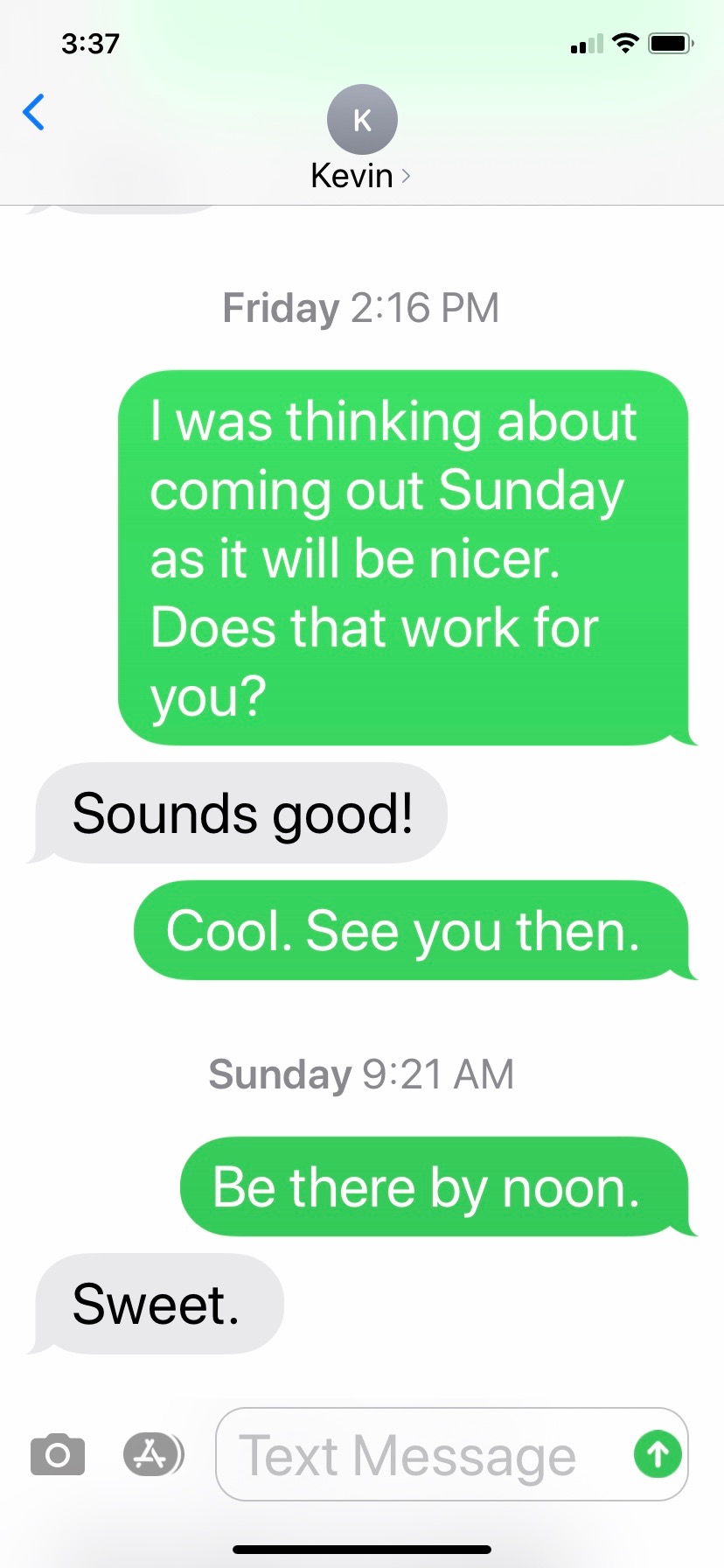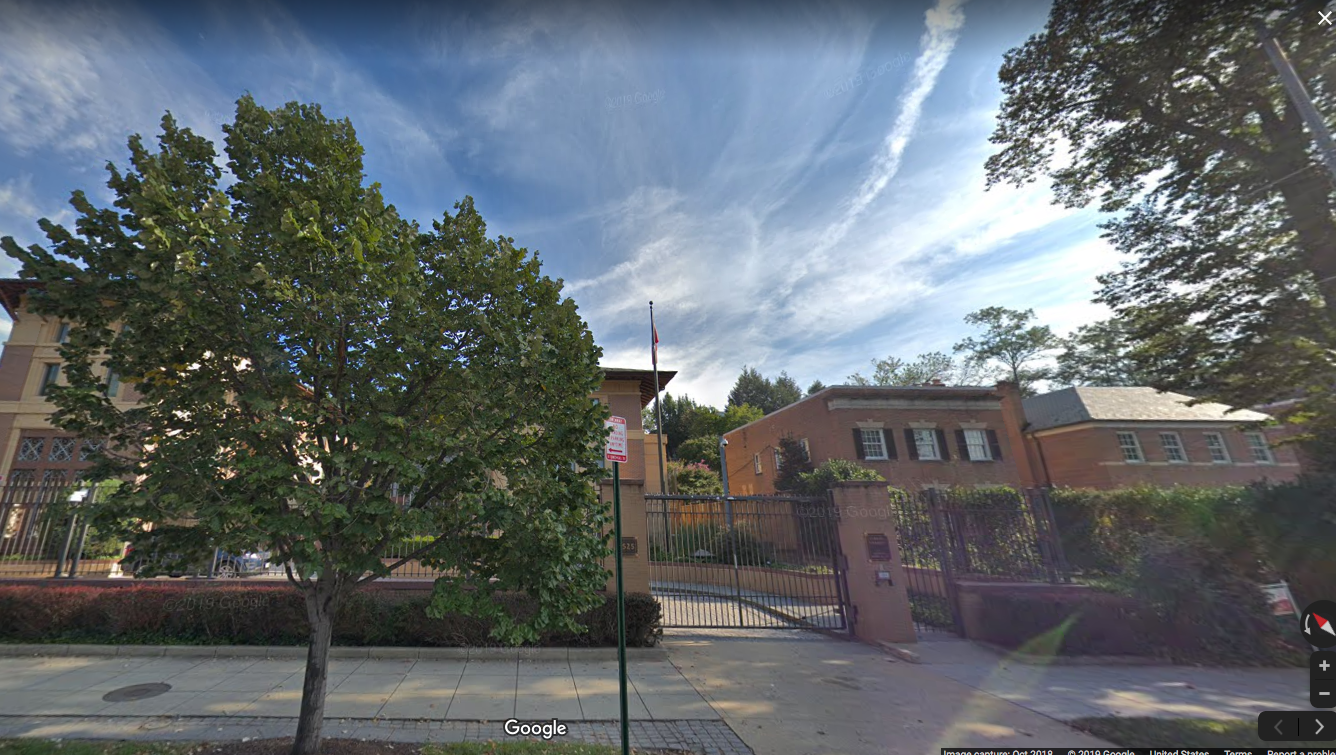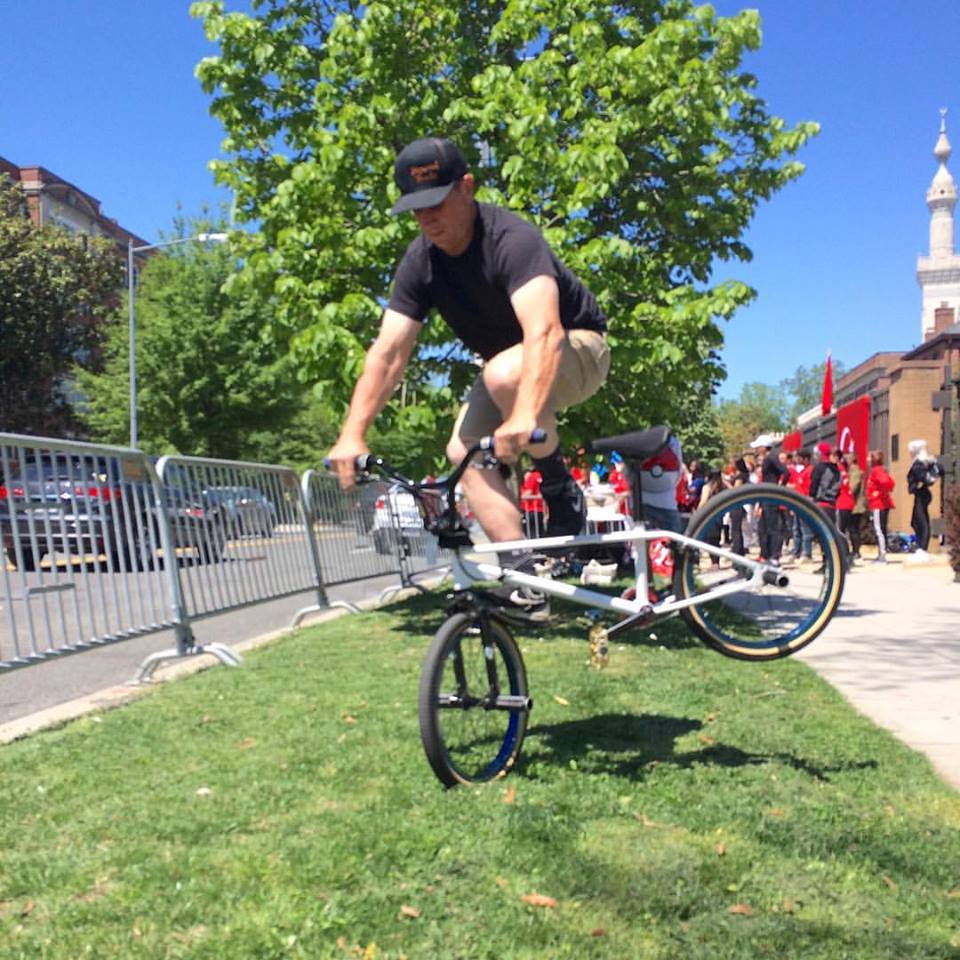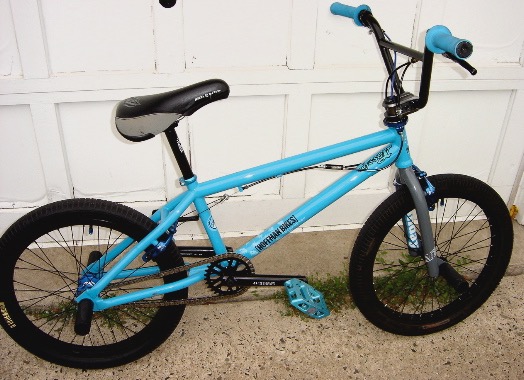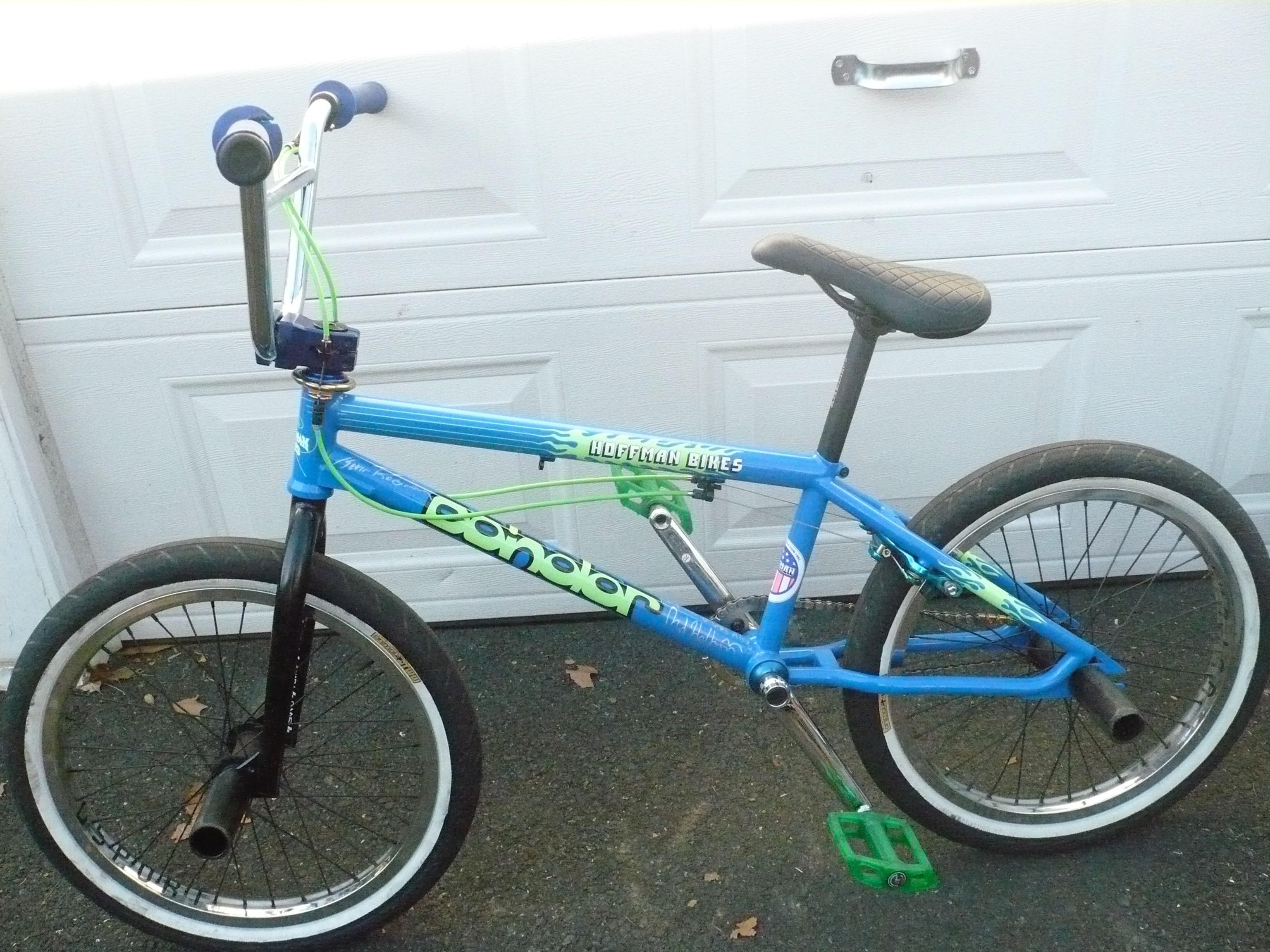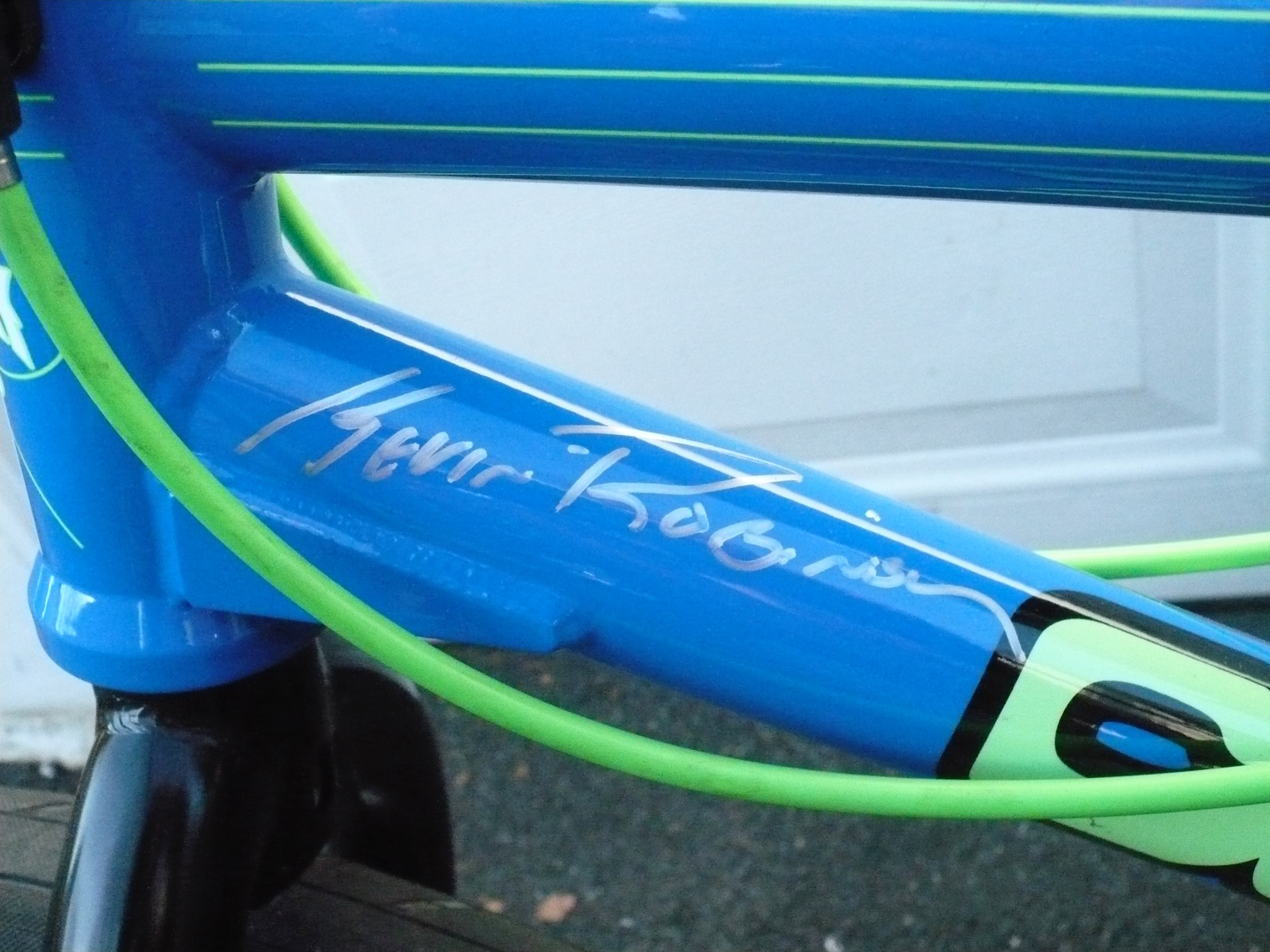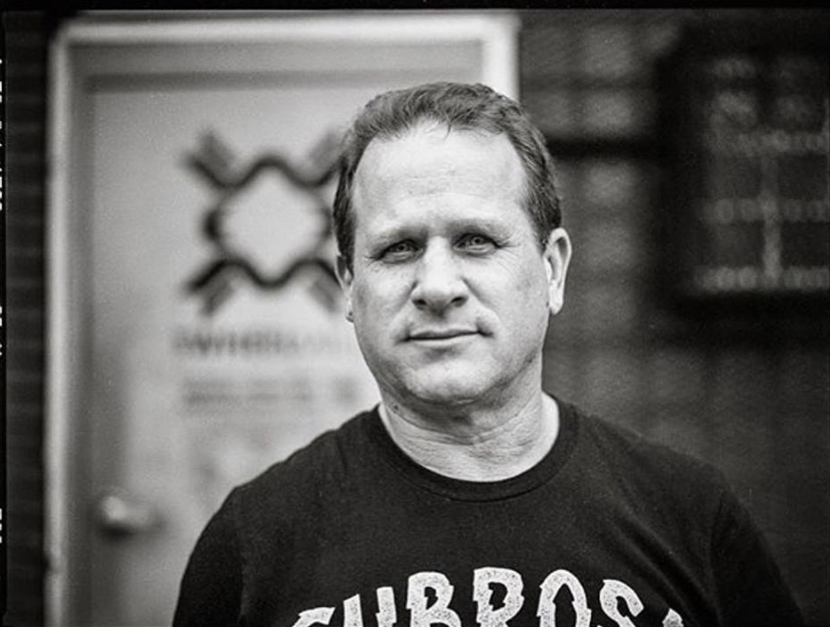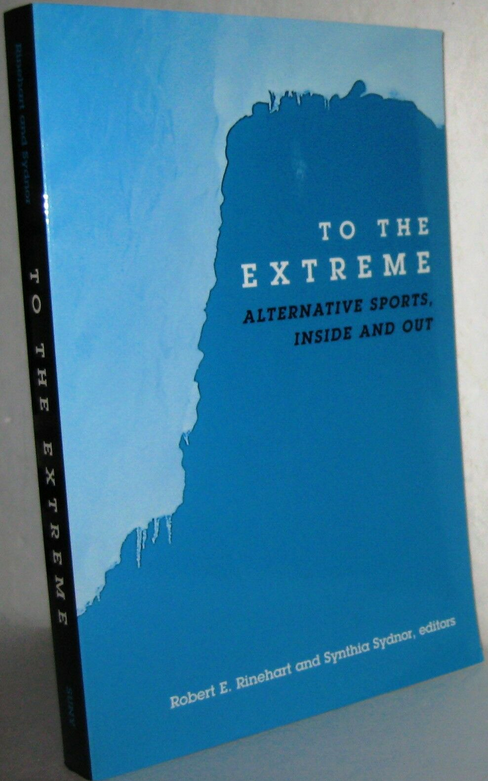
I first got online about 1996/97. There wasn’t much on the web about BMX at the time but I found a few sites. I had already been written articles for several BMX magazines and posted a few articles online. One day I got an email from a guy named Robert Rinehart. He was a professor of Kinesiology at Cal State University. He told me he was planning a book on Alternative Sports. He wanted to cover several sports with each sport getting two chapters; one by and athlete and one by a scholar. It was to be used in University classes as a text book. He asked if I would contribute a chapter on BMX.
Now at this time, The Extreme Games had just happened in 1995 and for the next few years, “Extreme Sports” as they were known, were all the rage. The phenomena was great enough that it deserved study as both a cultural shift and sporting departure into new activities and away from the classically structured sports previous generations grew up with.
All I was really told was that he needed ten pages. I was given no direction of any sort so I thought to truly represent the sport, I’d have to have teach some of the history as well as get into the lifestyle of a BMX rider. When I finally sent if off to be edited, I quickly got an email saying “Ten pages Double Spaced“! Whoops! Rather than whittling it down, I decided to write a whole new chapter for the book. Eventually it was published and one day I got a call from a riding friend’s wife who came across the book in one of her classes at Penn State.
I sat on the original article for a year or two and then submitted it to a (now defunct) website I had been contributing to called “NotFreestylin’.com”. They were stoked to publish it but I had one condition, I didn’t want my name on it. Since I had included the group of riders I had grown up with as primary influences, I wanted it to be anonymously published as I didn’t want to catch any negative vibes from anyone else in the sport. When it came out, it seemed to go over well. In fact, both Mat Hoffman and Bob Haro mentioned it in separate conversations with me as being the best history of the sport out there at the time.
When the site went down, I still had the original chapter on a 3.5″ floppy disc but that did me no good with my next computer. Eventually, I found the wayback machine and was able to find an archived version of the text, but not the web pages themselves.
The text is still an interesting read, especially when you view it knowing that it was written in 1997 and published in 1998. If you were riding before or at that time, you will get it. If you weren’t around back then, it’s still worth a read with BMX going to the Olympics this year. I ended the chapter talking about riding in my parking lot and you know what? I rode in that very spot yesterday.
Here is a link to the article: https://web.archive.org/web/20020102114335/http://www.notfreestylin.com:80/historyspeaks.html
Here is the first chapter I wrote:
Small Bikes, Big Men
Before I get too involved into this chapter I feel the need for an explanation of what this activity actually is called. Extreme BMX is simply a marketing catch phrase invented to earn money for television. BMX, which stands for bicycle moto-cross racing, is racing light weight 20” bikes around a dirt track with up to eight riders trying to cross the finish line first. Freestyle bicycling is an all encompassing term for stunt riding on bicycles. Be the riders on dirt jumps, vertical half-pipes, plywood ramps, street obstacles or simply a flat parking lot it is all Freestyle. Let me forewarn all readers not to call us “Extreme BMX’ers”. We take it as an insult and a commentary on the foolishness of those who don’t ride.
Freestyle has perhaps the oldest roots of all the new sports of the nineties. Generations of young people have ridden no-handed, jumped off a curb or tried some type of stunt. Modern freestyle stems from this adventurous side of bicycling. As riding evolved from simple stunts to dirt jumping to bicycle moto-cross racing to trick riding to ramp riding the athletes have always based their sport primarily on the simple aspect of having fun. Despite its roots, freestyle is separate from regular mainstream sports. Money has never been a motivating factor in freestyle. Neither has the idea of prestige that comes with being a star in other sports. This, among other things, separates freestylers from other athletes. Freestylers are a different breed from traditional athletes.
The history of the sport is most important in explaining what it is, where it is going and the attitude behind the athletes involved in this activity. Up until this writing there has not been an account of the evolution of the sport into the late 1990’s. This is not all encompassing but it does state the facts which have established today’s state of riding.
The genesis of freestyle can be traced back to the 1970’s first boom of bicycle moto-cross racing. BMX’ers sprinted around dirt tracks in a pack of riders in order to cross the finish line ahead of the competition. As simply racing around a dirt track became boring or commonplace, the early racers were always looking for new challenges for their heavy duty bikes. Although freestyle is an evolutionary process, one rider in particular is credited for creating it. His name is Bob Haro. Haro, who was also a skateboarder, decided to take his bicycle into the cement skateparks of the late seventies in Southern California. Adapting skateboard moves to his bicycle, he started something of a fad. Others soon joined in and the ball of progression started rolling. Adapting vertical oriented tricks to a parking lot, he created what is now called flatland riding. Haro was not only a rider but a shrewd businessman, starting his own company and dominating the 1980’s scene, but more importantly he was an artist.
The largest BMX magazine of the day, BMX Action, hired Haro as a staff cartoonist. When not drawing, Haro was riding and teaching the editor’s son his tricks. The editor noticed how exciting their riding was so he began to photograph the pair and explain how to do the stunts for the readers. Introducing them as the BMX Action trick team, public exposure to “Trick Riding” as it was then called, had begun. The print media would dictate how freestyle was presented and the direction it would take.
Freestyle in the early 1980’s was not considered a sport or even separate from BMX. When not racing, most BMX’ers goofed around with wheelies or the stunts featured in the magazines. This grass roots interest was widespread due to the magazine reader base. If you owned a 20” bicycle, you could do at least a couple of small tricks. As the technical skills of the riders grew, freestyle started to outgrow the shadow of BMX racing and mature into it’s own.
The greatest leap in the history of freestyle was made in the spring of 1984. The editor of BMX Action decided to dedicate a magazine solely to “ Freestylin’ ”, as the title called it. Other publishers in the BMX world were soon to follow with their own efforts but Freestylin’ was the rider’s bible. This magazine was not just a bicycling guide and reporter but a lifestyle primer. The editor, Andy Jenkins, was free to present his own attitudes toward life and how the sport would be presented to the readers. The staff also had similar input. Their philosophy was not to simply report but to influence the readers and riders in a new way of viewing their sport as a microcosm of the world around them. Freestyle became more than a sport, it was a lifestyle. Freestylers were outside the norm of society and adapted that status to other areas of their lives.
Freestyle became an “alternative” sport both physically and mentally. Freestylin’ was about progression highlighting new tricks, new riders and new styles never limiting their horizons. The photography, writing and attitude would influence rider’s and the other media. Freestyle reached its first peak in the years 1986 to 1988. Literally thousands of aspiring riders took to the streets. The industry boomed with new companies manufacturing everything from bicycles to shoes to tee-shirts. At one point in time there were over six national magazines based on 20” bicycling and hundreds of underground “zines” privately published by riders. Sponsors for riders came from corporations making products not involved with freestyle such as soft drinks and zinc oxide sunburn protection. This was also the age of the gimmick. Accessory parts that were virtually useless were sold to riders with promises of accelerating them into the limelight. Freestyle was a ship overloaded with newcomers and non-productive baggage that was destined to sink.
The bottom started to fall out in 1989 as companies began to withdraw their money in freestyle promotions. The market had become saturated and interest waned. Magazines folded or morphed back into bmx and freestyle coverage. By 1990 the main freestyle sanctioning body, the American Freestyle Association (the AFA), was closing down. Upstart companies disappeared and the remaining manufacturers cut back their programs. The market had been saturated and their was nowhere to go but downhill. In 1992 the once mighty Freestylin’, which had been restructured and called “Go- The Rider’s Manual” died a victim of withdrawn advertisers. While many riders fell out of the scene, an underground was firmly established and was determined to persevere freestyle. This underground kept together without any major competitions and only one magazine surviving the purge. Riders put on their own local contests and even non-contests called Jams in which they simply got together and rode without any judging or competition. Just for the fun of it and with no hidden agenda, jams were underground and usually illegal. Imagine a local parking lot suddenly full one day of one hundred or more bicyclists without any warning or explanation. The remaining manufacturing companies didn’t know what to make of these jams as they did not promote their products. The remaining magazine however helped spread the word and cover these events as they had done in previous years with the national competitions. Homemade videos also united these enclaves of riders as they let one part of the country know what was happening in another. Freestyle as an industry was at a stand still even though the riding continued to progress.
As corporations were no longer spending money on research and development of freestyle bicycles and accessories the riders soon found themselves transcending the capabilities of the bikes they were riding. Riders worldwide were fed up with braking parts and inferior products. Freestylers had to solve this problem on their own. Using the determination and practical knowledge they gathered from learning to ride and earnings they had amassed when freestyle was big, riders started manufacturing bikes and accessories on their own. Companies such as Hoffman Bikes, S&M; and Standard Industries were among the first. Immediately successful, these rider owned companies put out superior products to the big manufacturers but more importantly they also sold attitude. The average rider felt betrayed by the big companies backing out of the scene, shutting down magazines and selling obsolete products. In buying a bike from a rider owned company, freestylers could strike back at those who had wronged them. The rider owned companies also put money back into the sport by creating ramp parks as gathering places for riders and holding contests to promote the sport and unite the riders. Even underground clothing companies that were operated out of the trunk of a car sponsored riders and held competitions. The riders took their sport from the ashes of the 1980’s boom and re-claimed its once stripped soul. This is when the riders finally got control of their sport and would be able to guide it in the direction they chose.
Matt Hoffman, unquestionably the best vertical freestyler ever, was the man to bring freestyle to the masses once again. Matt decided to present a national freestyle contest series together to fill in the gap that the AFA left. Matt called his series the Bicycle Stunt or BS series. This flippant name was a direct reflection of the new attitude in freestyle. Now riders would compete not out of pressure from the media or sponsors but because it would be fun again. The BS series learned from the mistakes of the AFA contests and changed the style of competition. The pace of the action was now uptempo and the judges were also riders not industry employees as had been before. Since there was practically no money supporting freestyle, the contests were no longer pressure cookers about winning to please sponsors or gather coverage in the media. It didn’t matter that the professional winnings were meager. The attitude was to perform at your best and support anyone else who was riding. The BS series from 1992-1994 was like a series of family reunions based around a contest. The riding had progressed incredibly throughout the world and the BS contests brought everyone together. The series was all about the independent rider and having a good time. This rebirth was one of the most exciting times to be involved in freestyle. The BS contests were successful and began to get noticed by the media, particularly ESPN. Hoffman was approached by the sports network and was offered backing for the contest series. This was the beginning of the Extreme culture.
The summer of 1995 brought ESPN’s Extreme Games, an Olympic style gathering of what were previously called alternative sports and brought them together under the “Extreme” label. The Extreme Games brought freestyle back into America’s living rooms although it was barely publicized behind mountain biking. No longer were the riders dressed in old fashioned neon colored BMX uniforms and doing balancing or hoppy tricks. After a seven year hiatus, freestyle debuted itself anew. This breed of athletes were launching themselves and their bikes through the air doing seemingly impossible variations at incredible heights. Freestyle was the most popular event at the first Extreme Games and would take a preminent spot in future Games.
This brings us to the present state of freestyle.
Today freestyle is bigger than ever no doubt attributed to the media coverage coming from both print and television. More and more riders are jumping, ramp riding and practicing flatland tricks. With this new attention there is an air of excitement but also apprehension. Those who are old enough to remember the demise of the scene nearly a decade ago see big corporations interfering and molding the sport into a media friendly entertainment spectacular. We fought to keep our sport alive and do not want to lose control. We have molded the freestyle to our liking and do not want to see a group of outsider’s tell us how, where or why to ride. There is also a resentment when we see corporations doing millions of dollars of business based on freestyle and not giving the actual riders their fair share. Contest winnings are set low based on the dollar amounts of when freestyle was doing one third the business it is today. After all it is the rider who risks his neck and not the executive. Now I am not saying that I should be able to walk into Taco Bell and get a free lunch by showing the scars on my shins but we should get something in reciprocation. The riders feel the BS contest has been taken away from them yet they also know the exposure is good for the sport. We do not want to see our sport die again but we will not be manipulated. Currently several of freestyle’s top professionals, upon whom ESPN relies, are considering joining together to prevent the corporate rule of the sport and protect it’s integrity.
To understand the mind set of a freestyler is to understand their personal evolution and the trials and tribulations he faces. Most riders start as you would expect by doing simple stunts or jumping curbs. Then something clicks. The rider realizes that he is having fun and is challenging himself. Graduating to bigger jumps and trick is the next logical step and “Presto”, a freestyler is born. That’s it. We just keep riding and riding and would never consider it “practice”. Fun and progression are the motivating factors. Freestylers don’t get status in school the way a star quarterback does. We don’t get the scholarships of straight “A” students. We don’t get the admiration given to a basketball hero. Our dedication to our activity is as consuming as the others but usually the only reward is personal satisfaction and a pat on the back from a couple of friends. There are so many strikes against freestylers it is simply an accomplishment to sustain your riding. Let’s start off with pain. Moms and dads don’t like to see their junior come home bruised, bleeding or broken. (Ever noticed the proliferation of soccer leagues replacing midget football?) To freestyle is to get hurt. Injuries, both minor and major, are simply a fact in a riders life. Minor injuries are the bumps and bruises from falling against the bike. One of the most common areas to get whacked is the shin. When a rider makes a mistake his shin almost always get smashed against a pedal or the handlebars. In fact, one pro actually went as far as getting a bulls eye tattoo on his shin. Major accidents often result in broken bones, knocked out teeth and blown out joints .We accept it, parents and girlfriends don’t. Another obstacle is simply the cost of a quality bike. When flying through the air or precariously balancing on one wheel a rider must have confidence in his scoot. A top of the line freestyle bike can cost minimally $700 and upwards of $1300. Also freestyle bikes do not age gracefully. Wheels bend, frames crack, tires wear out and forks snap off. Maintaining a bike can be as expensive as buying one or two a year depending on the rider’s choice of componentry. I may as well add the price of clothes, shoes and protective gear. A full set of pads costs about $150. Helmets range in price from $40 to $300. Shorts and tee shirts are constantly being torn and grease stained. Riders also go through sneakers at the rate of at least three pairs a year. Flatland riders in particular are known to wear out pair of sneakers in less than a month. At an average of $50 bucks a pop it’s enough to make Michael Jordan glad he’s hooked up.
Next comes the riding zone itself. Ramp riders are often faced with spending hundreds on backyard ramps or being stuck paying entrance fees to skateparks that have the ramps. Trail riders, the dirt jumping contingency, are faced with finding plots of land that are otherwise unused to build their jumps. Empty lots, woods and parks are the usual locations. Quite often jumping spots pop up and riders are quickly chased out by property owners, cops or park officials all screaming about liability risks or trespassing. Trail riders also face the characters who also frequent these otherwise abandoned places; druggies, hoodlums and couples with no other place to engage in intimacies. Street riders use the environment around them as their palate. This often means loading docks and ledges, walls and fences, banks and lawns. Again property owners and police are quick to attack with claims of trespassing and vandalism. Flatlanders ride in parking lots or on basketball or tennis courts. The old liability excuse chases riders out of their spots as well as claims that the courts are not made for bicycles. I have tried to explain that the difference between tire marks and court shoe marks on the ground is negligible until I was blue in the face. The rebuttal I always get is a threat that the police will be called to arrest me for trespassing.
Like any other sport, riders need to learn the skills involved. The time it takes is much greater than most people expect. Freestylers often ride every day for hours at a time. Teenage riders are constantly told they spend too much time on their bikes. Riding time often is found at the expense of homework time. Flatlanders practice the most as their stunts are not based on huge burly flights but incredibly technical maneuvers. Professional flatlanders generally ride six to ten hours each day, every day. The time commitment is grueling but remember the riding is based on fun. Many riders travel to warmer climates in the Winter and cooler climates in the Summer. No off season exists in freestyle. It is a full time job although only a rare few make enough (if any) money to survive. With the time requirements necessary it is impossible to hold a full time job. Riders are often stuck with part time, bottom of the barrel jobs. One friend was one of the premier flatlanders in the world and pulled weeds or worked the graveyard shift at a convenience store to earn money. Freestylers again feel alienated from society but we take a pride in achieving the goal of simply putting in the time on the bike.
Lastly, an omni-present detraction is the public. As odd as this may seem to say in the age of “Extremeism”, most riders do not want the attention they get. No offense to those reading who are fans, but how would you feel if people felt the need to stare at you and comment upon everything you do. Although I am sure the questions people ask are not mean spirited, they can be enough to make you throttle them. “Who taught you that? Can you do a back flip? Do something cool? How much does that bike cost? Is that a GT?” In any other social situation it is considered bad form to interrupt someone engaged in an activity with inane comments or questions. Would you laugh at an Olympic gymnast when she falls off the balance beam? How about when a tennis player lunges for a ball and sprains an ankle? I don’t know why riders are exempt from this rule. Of course you will always have the redneck screaming out his car window “HEY FAGGOT!!!” as he drives by but it is the ordinary people that we find so insipid.
Now that I have ranted about the demons we face I want to point out the rewards from freestyle riding. Both intrinsic and extrinsic, it keeps the wheels spinning from day to day, month to month, year to year. Initially I can not state strongly enough that freestyle is based on having fun. Imagine your favorite roller coaster ride. That is what a trails rider feels as he goes through a rhythm section of ten closely packed jumps. Flatlanders glide across the pavement with the finesse and flair of a figure skater. Ramp riders soar beyond gravity’s boundaries, contorting themselves in space before touching back down to earth. The adrenaline rush is addictive. The sense of accomplishment is fulfilling. The knowledge that you have just done something a very few can do establishes you as distinct from society around you. The act of riding is it’s own self-fulfilling reward.
Although freestyle is an individual sport in that only one person fits on a bike, one of the most rewarding aspects of riding is the friendships made. Bonded by a common passion, riders do more than ride together. We talk, travel the country to competitions and shows, push each other to excel and share experiences. The friends I have made from riding are all over the country and we will always feel a kinship. We know what each other is going through. We cheer for our friend when they succeed and give them a ride to the emergency room when they don’t. For a select few, freestyle has tangible rewards as well. It often starts with a friend giving you a part when you break yours. Product sponsorships from companies can help out the rider as he puts his bike parts and clothing through the paces. Bike sponsorships are even more rare and are an achievement to be coveted due to the financial concerns it removes from the rider. Some riders make money from sponsors by performing in shows. Others simply go to a public place and throw a hat on the ground the way a street musician would. As big as “extreme” sports are today it may surprise some to find out that it would be conservative to say that less than five percent of the sport’s professionals actually make a living from their riding. Of course there are a some who’s yearly income is in the six figure range but most pros make less than ten thousand a year from the sport in which they are considered professional.
Perhaps the silliest reward is that of simply being out in the world. When you spend most of your time riding your bike you are able to witness some of the wonders the world has to offer. We see the crazy people who roam our streets unnoticed to most. We even name them. Crazy C, Cha-Cha, L.G.R.G., Buddio and the golf guy are all parts of my riding experience. We see car accidents, fires, mothers slapping their kids and beautiful sunsets. We see crimes being committed and bones being broken. We see drug deals and back seat romances. It’s a crazy world out there and the freestyler in your neighborhood is part of it. Ask any rider about something unbelievable they have been a witness to and I am sure that they will not let you down. Probably my favorite story comes from a friend who rides flatland. He was practicing in his normal parking lot when he saw a strange car pull in and park at the far end. The driver sat behind his wheel watching for about an hour, studying the tricks. Firing up the engine he slowly approached. With a wag of his finger he signaled my buddy. Rolling over cautiously, Joe replied “Yeah?” The motorist pulled out a gun and pointed it toward my friend ordering him “Do your best trick.” When was the last time something like that happened to little Timmy at baseball practice?
With all these rewards and detractions shaping a rider’s personal experience, it is understandable why we do not like being called Extreme BMXers. We don’t call ourselves Extreme. We are just riders. The non riding public who see us on television call us Extreme. To have the society which rejects us or a big money corporations that won’t compensate us for our talents: labeling what we do for mass consumption marketing is degrading. The last thing we want to do is ride for anyone but ourselves.
The goal of freestylers is not acceptance or even financial success. First and foremost we all seek progression in our riding. If money, fame and glory come, so be it, but we will never be satisfied with only that as there is always a new trick to learn, ramp to ride, dirt mound to jump. Maybe this will be the downfall of freestyle as those who ride are preoccupied with riding, leaving the decisions affecting the growth of the sport in the hands of corporate heads who never did stunt number one. As the riders of the 1980’s generation grow up many of them see this danger to their sport and are taking steps in order to prevent the sports collapse all over again. Call us skeptical but we don’t trust you just because you offer us a small paycheck or a chance to be on television. If the newcomming riders don’t learn from the history of the sport they will unquestionably accept the marketing of freestyle as Extreme. This dependency is what scuttled freestyle ten years ago and threatens to do the same today.
Purposefully, I have tried to not drop a lot of names but I feel that to properly represent freestyle I must mention a few whose impact has been so great that they are directly responsible for the current state of the sport. Without these riders, freestyle would not be what it is today. If you ever meet any of them remember to say thanks. As I stated earlier, the man responsible for bringing freestyle to the masses is Matt Hoffman. His introduction to the world came when he wrote to Freestylin’ magazine at the age of thirteen. He sent a picture of himself doing a ramp aerial (shooting off the top of a vertical ramp, turning a 180 and dive bombing back down) at a height that was comparable to or higher than the pros went. Matt quickly was picked up by sponsors and reinvented ramp riding. Making up tricks that no one had ever imagined at heights thought unobtainable were commonplace in Matt’s riding. He would do two or three stunts in mid air boggling the minds of those who saw him. One of the most difficult and dangerous ramp tricks is the 540 degree spin. Matt started doing them at unbelievable heights no-handed. He was also the first rider to land 900 degree spins in public. Although not the first rider to perform a flip, Matt was the first rider to do them in contests and bring the trick to it’s level of popularity among both riders and fans. If he had never brought freestyle to the public through ESPN or the television shows that featured him or started one of the most successful bicycle companies, Matt would always be remember for his riding. He is still competing today although his years of injuries are finally catching up to him. When he is healthy, his riding never disappoints and he is still able to win a competition at any time.
In the dark days of the late 1980’s as the industry was dying, one Californian misfit brought back the fun to riding through dirt jumping. Chris “Mad Dog” Moeller started off his public career as a test rider for BMX Action magazine. His job was to ride and evaluate BMX bikes and be stylish while he was doing it. At a time when riding was slowing down due to the overproduction and glamour of the previous boom, Chris reminded everyone why we started riding in the first place. He was featured in the magazines, often on the cover, jumping insanely dangerous jumps and doing new, innovative tricks. He was having fun at it too. Chris had a wild style that the remaining companies couldn’t accept and he refused to change. He entered contests dressed as the Fonz or with smoke bombs attached to his bike. As a BMX racer, he was a risk taker often to the dismay of the “serious” pros around him, soliciting more than a couple of punches. Through his association with the magazine he also had a forum to present his views. He took a minimalist view of riding calling it BSR for bicycle soul riding. Telling us that riding was not about factory sponsorship, money or fame, Chris gave us a dose of reality and inspired us to keep riding while the industry faded around us. The current fascination with dirt jumping is a result of the antics and riding of Chris Moeller. Today like Matt, he owns a popular bicycle company and although he no longer competes, he can still ride and keep up with the best.
In the realm of flatland riding one name stands head and shoulders above the rest. Although he hasn’t competed or ridden in public in nearly seven years, he is still considered one of, if not, the best. His name is Kevin Jones. Out of nowhere, Kevin hit the national scene in 1987 at a competition in Austin, Texas. He debuted not only new tricks but a whole new style of riding. He was at least a year ahead of his competition as far as the difficulty level of his tricks. He was innovating and creating his own tricks as opposed to doing what the magazines showed the top pros doing. Kevin continued to make up tricks that dumbfounded flatlanders and create his own style that influenced everyone riding and is directly responsible for the state of flatland today. His tricks are still being done in competitions at all skill levels. There are even a few out there that no one else can do.
With as promising a career as a rider could hope for, Kevin threw the world a curve ball when he decided to quit competition at the height of his popularity. This was a revolution as he decided that simply riding was more important than preparing for contests or performing for crowds. The freestyle community was shocked by this decision as riders had always exploited their talents to the fullest extent. Kevin became a legend. He was seen as the true rider, dedicated to the art while not in it for the money. The only way he was seen was through videos or if you went to see him at his favorite parking lot. Rumors flew about what he was doing and he became even more legendary through the mystery surrounding him. Kevin still rides and toys with the idea of competing. If he does he would definitely be near the top of the pro class, but more importantly he will be the only rider to do a routine in which he invented every single trick. No matter what place he finishes, that is what makes him the best.
As I have stated, ramp riding, dirt jumping and flatland riding all make up the sport called freestyle. I have highlighted riders who excelled in their specific areas there is one in particular who is a master of all. At competitions the riders who enter more than one aspect are considered for the overall riding title. Throughout the history of freestyle competitions only one rider has been the overall champion. In each of the last eleven years the title has gone to Dennis McCoy. Hailing from the unlikely town of Kansas City, Missouri, Dennis popped onto the scene in 1986. All the best riders were from California and Dennis came to their back yard and beat them at their own game. Primarily a flatlander, he was also good enough to score well in ramps to win the overall in nearly every competition. As his riding developed Dennis put the emphasis into his ramp skills becoming one of the top five ramp riders in the world. Beside the overall title, he has also won flatland and ramp titles individually. While riders usually try all types of freestyle, few excel at all realms. Dennis is the epitome of what a rider wants to be. He has more natural ability and the daring to push the limits than nearly anyone. Since he can ride anything, he has developed a unique bike control that only helps him continue to get better with each passing year. At 31, he is the oldest competing professional but his age and skill is an asset even among riders who were in diapers when he was jumping his bike. One day Dennis will stop competing but he will always be considered as perhaps the best rider who ever swung his leg over a bicycle.
Lastly as I list the greatest influences of today’s freestyle scene I must bring up a team of riders. Though all the riders were individually good, together they impacted the sport in a way that is unparalleled by any other group of riders. Starting off as ramp riders, they called themselves the Plywood Hoods due to the many midnight runs made to local construction sights to steal ramp wood. As teenage boys they were a tight knit group of friends who rode together and pushed each other to progress. Eventually specializing in flatland, they continued to also ride all aspects of freestyle which went against the norm of specialization. Two of them became nationally prominent riders which drew the media’s attention. Freestylin’ magazine featured this mostly unknown team in a cover story and interview. The Hoods spoke about how they had fun riding and were not supported by factory sponsors or even their parents. The attitude was that they did what they wanted without concern for what might hold them back. The Plywood Hoods became heroes of the underground riders. The average kid could relate to the team better than the superstars of the day.
Beyond their riding, The Pylwood Hoods also took the state of affairs in freestyle into their own hands. One published a ‘zine called Aggro Rag. While most homemade magazines were about eight pages of photocopies of friends riding, Aggro Rag was up to fifty pages with color featuring uncensored interviews and commentary on freestyle. Aggro Rag’s publisher is now the editor of the largest BMX/Freestyle magazine. Inspired by early skateboard videos, the Hoods took it upon themselves to make the first freestyle video, humbly entitled “Dorkin’ in York”, and distribute it with the slogan “Copy it for your friends-we would”. Each year a new video was released featuring state of the art riding and increasingly better production quality starting a million dollar a year industry. In fact, ESPN even used some footage from a Plywood Hoods video in their broadcast of 1996’s Extreme Games. When the AFA was in its twilight, the Hoods held the first York Jam, named after their hometown in Pennsylvania. The jam was a non-competitive riding session that was the first non-industry national gathering of riders that would set the precedent for other jams and independent contests. The jams continued for five years attracting riders from as far away as Europe and Australia. In 1991, they put on an independent freestyle tour without any major sponsors. When one of the Hoods was approached by a bicycle company to design a frame set, he sat down with another Hood and together they designed what several riders consider the best overall handling bike ever.
The Plywood Hoods are not listed by name as their lineup was (and is) continually changing but still based on the original members. To be on the team all that was required was the desire to ride and the proper attitude of not taking yourself too seriously and keeping it fun. The Plywood Hoods took their sport into their own hands and would inspire the independent spirit of Freestylers everywhere. No matter what obstacles a rider faces, as the Hoods said at the end of one of their video’s credits, “Just ride, that’s the bottom line”. Lastly, I want to present what freestyle is to the bicycling industry as a whole. Freestyle is the Rodney Dangerfield of bicycling. It gets no respect. Walk into any bicycle shop and if you see a freestyle bike it will be in the juvenile section. No matter that riders like Dennis McCoy or even myself are into our thirties, our bikes are still considered juvenile. Shop owners often ask me why I don’t ride a mountain bike like I should at my age. I usually tell them that I can do more on a 20” bicycle than all the riders working in the shop ever will on any bike. Many top of the line bicycle shops that pride themselves in being the best shop in the area for serious riders do not even stock freestyle bikes. Freestyle is considered a fad. Even as popular as freestyle is today many shop owners are hesitant to invest money what they think will be out of the public’s interest in a couple of years. They never consider it to be as serious as road or mountain biking. Maybe if we wore spandex too, hmm….
To the manufacturers of bicycles, freestyle is also considered a juvenile fad for the most part. Some companies are giving freestyle a new respect and treating the riders as individuals rather than a demographic group. Slowly frames are being designed for riders who are bigger than the average fourteen year old. Most of the true innovations in freestyle bicycle designs are still made by rider owned companies and then copied by the huge manufacturers. With all the money the huge, famous companies have you would think they would want to innovate but they usually follow the trends looking to sell product. If the large companies try to be innovative they often throw gimmicks into the ring which lessens the credibility they were looking for in the first place. I have tried to present freestyle as I have experienced it in my years of riding. Out of this writing I want the reader to realize that the kook you watch on television flipping, spinning and hurling himself through the air is a true athlete not some “Extreme” jackass trying to cripple himself. We are trying to push ourselves to the limits and feel both the elation and agony of other athletes. We are in it for personal achievement not glory. Now that you know about the history, the ongoing daily pursuit, the influential riders and the way we are perceived you may gain a new perspective. Freestyle is not a shooting star burning bright only to fade to black. It will be around long after it stops being popular to the masses. Freestyle belongs to the riders not the public. We thank you for your appreciation but don’t try to tell us who or what we are.
Where Freestyle is headed from here is up in the air. It may die again the way it did ten years ago. It may hold a steady pace and continue in its present course. Maybe it will explode and be in the Olympics the way snowboarding did in 1998. It is up to cooperation of the media, the industry and the riders to determine how freestyle evolves. If all parties look to the mistakes of the past, heal old wounds and treat each other fairly, freestyle could become accepted in the world of mainstream sports. All I am sure of is that no matter the direction freestyle takes going into the next millennium, I will still be out in my parking lot riding as you drive by staring at me.










